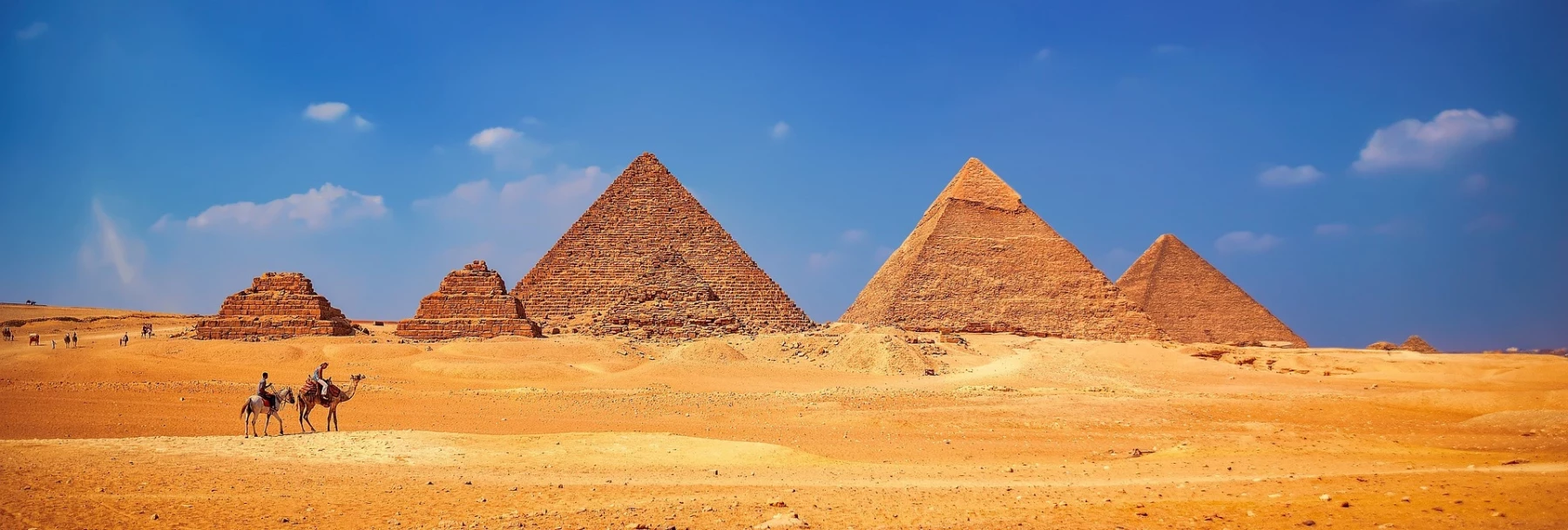The 11 essential things to do in Cairo
Last update : 26/05/2024 15:39Summary
- To visit
-
- 1 - Visit the Pyramids of Giza
- 2 - Explore the Egyptian Museum in Cairo
- 3 - City of the Dead
- 4 - Stroll through the old Islamic city
- 5 - Visit the Coptic Quarter
- 6 - Khan El Khalili market
- 7 - Manial Palace
- 8 - Al-Azhar Park
- 9 - Take a Nile Cruise
- 10 - Visit the Citadel of Saladin and the Mohammed Ali Mosque
- 11 - Cairo Tower
- Cairo - Where to Stay?
- Cairo - How to get around?
- Cairo - Best period
Cairo, the jewel of the Middle East, stands as an essential destination for travel enthusiasts seeking immersion into the heart of Egyptian history and culture. The city unfolds a journey through time with its narrow alleys in the Islamic old town, where colorful markets and historic mosques narrate the ancient tale of this dynamic metropolis. The Giza Pyramids, majestic sentinels of the past, dominate the skyline, providing a tangible link to ancient Egypt. The Egyptian Museum in Cairo, housing the treasures of Tutankhamun, beckons travelers to delve into the mysteries of pharaonic civilization.
The Coptic quarter, with its millennia-old churches, adds a spiritual dimension to the experience, while the bustling Khan El Khalili market provides a sensory immersion into Egyptian daily life. Modernity finds expression in the Cairo Tower, offering a spectacular panoramic view of the ever-evolving metropolis. The banks of the Nile, the cradle of Egyptian life for millennia, invite for a serene cruise, and Al-Azhar Park offers a haven of peace amid urban hustle.
Cairo's vibrant nightlife, with lively cafes and electric clubs, completes the experience, showcasing the diversity and vitality of this Egyptian capital. In essence, a journey to Cairo is a breathtaking adventure harmoniously marrying past and present, providing travelers with an immersive dive into the rich history and cultural vibrancy of this unique city.
1 - Visit the Pyramids of Giza
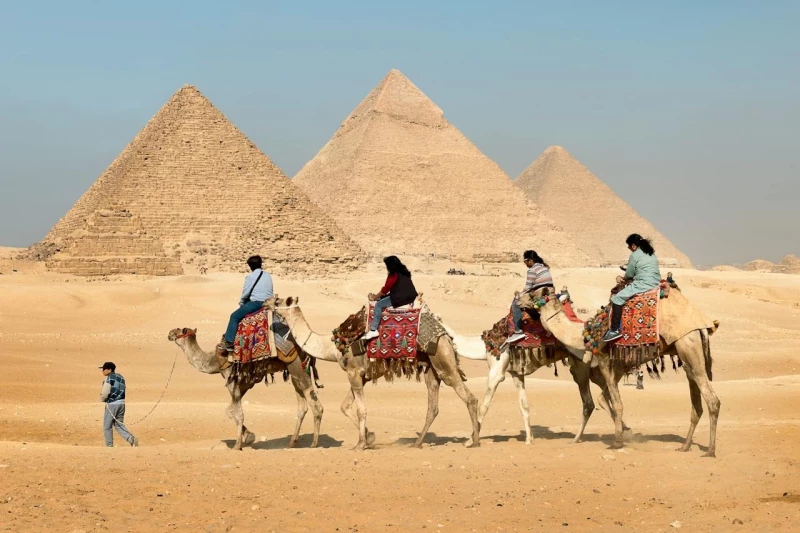
Visiting the Pyramids of Giza is a must-do experience for anyone traveling to Cairo. Here's what you can expect and some tips for your visit:
-
Explore the Pyramids: The Pyramids of Giza, including the Great Pyramid of Khufu (Cheops), the Pyramid of Khafre, and the Pyramid of Menkaure, are the most iconic landmarks. Walk around the pyramid complex and marvel at the sheer scale and architectural precision of these ancient structures.
-
Visit the Sphinx: Adjacent to the pyramids, the Great Sphinx of Giza is a colossal limestone statue with the body of a lion and the head of a pharaoh, traditionally believed to represent Pharaoh Khafre. Take some time to appreciate this enigmatic monument.
-
Enter the Pyramids (optional): You have the option to enter the Great Pyramid, though it involves navigating narrow passageways. Inside, you'll find the burial chamber and gain a sense of the pyramid's internal structure. Note that there's an additional fee for entry.
-
Sound and Light Show: Consider attending the Sound and Light Show at the Pyramids in the evening. This multimedia experience narrates the history of the pyramids through light effects and sound, creating a magical atmosphere.
-
Guided Tours: Hiring a local guide can enhance your experience by providing historical context and insights into the construction of the pyramids. Guides are available on-site or can be arranged in advance.
-
Bring Essentials: Cairo's climate can be hot, especially during the summer. Be sure to bring essentials like sunscreen, a hat, and water. Comfortable footwear is also advisable, especially if you plan to explore the area extensively.
-
Photography: The pyramids are a photographer's dream. Capture the stunning views of the pyramids against the backdrop of the desert landscape. Be mindful of the rules regarding photography, especially inside the pyramids.
-
Time Your Visit: Try to visit the pyramids early in the morning or late in the afternoon to avoid the peak heat of the day and the crowds. The lighting during these times also enhances the visual experience.
-
Respect the Site: The pyramids are UNESCO World Heritage Sites, so be sure to respect the rules and regulations. Avoid climbing on the structures, and refrain from littering.
Visiting the Pyramids of Giza is an awe-inspiring journey into ancient history, offering a glimpse into the architectural and cultural achievements of the Egyptian civilization.
 Our tips for getting the most out of your experience.
Our tips for getting the most out of your experience.
Visiting the Pyramids of Giza is an extraordinary experience. Here are some tips to make your visit even more enjoyable and memorable:
-
Arrive Early in the Morning: The pyramids are usually less crowded in the early morning. Besides avoiding crowds, you'll also experience cooler temperatures.
-
Wear Appropriate Clothing: Cairo can have high temperatures, especially in the summer. Wear lightweight clothing, a hat, and comfortable shoes for walking.
-
Stay Hydrated: Ensure you stay well-hydrated, especially if you're visiting during the hot months. Bring a water bottle to stay refreshed during the tour.
-
Buy Tickets in Advance: If possible, purchase your tickets online in advance to avoid waiting in lines on-site.
-
Hire a Local Guide: A guide can provide in-depth historical and cultural information about the pyramids, enhancing your experience. They can also assist you in navigating the site.
-
Avoid Persistent Vendors: You may encounter vendors selling souvenirs. Be firm but polite if you're not interested in purchasing, and continue on your way.
-
Plan Your Itinerary: The Giza Pyramids complex includes several sites. Plan your itinerary to ensure you don't miss anything, including the Sphinx and other nearby structures.
-
Respect Photography Rules: Some areas may have strict rules regarding photography, especially inside the pyramids. Respect these rules to preserve the site.
-
Bring Cash: Some attractions or services may require cash payments. Make sure to have local currency with you.
-
Attend the Sound and Light Show: If possible, consider attending the evening Sound and Light Show. It's a unique experience that highlights the history of the pyramids.
-
Ensure Your Safety: Take care of your personal belongings and keep an eye on your belongings, especially in crowded areas.
By following these tips, you'll maximize your visit to the Pyramids of Giza and fully enjoy this iconic experience of ancient Egypt.
2 - Explore the Egyptian Museum in Cairo
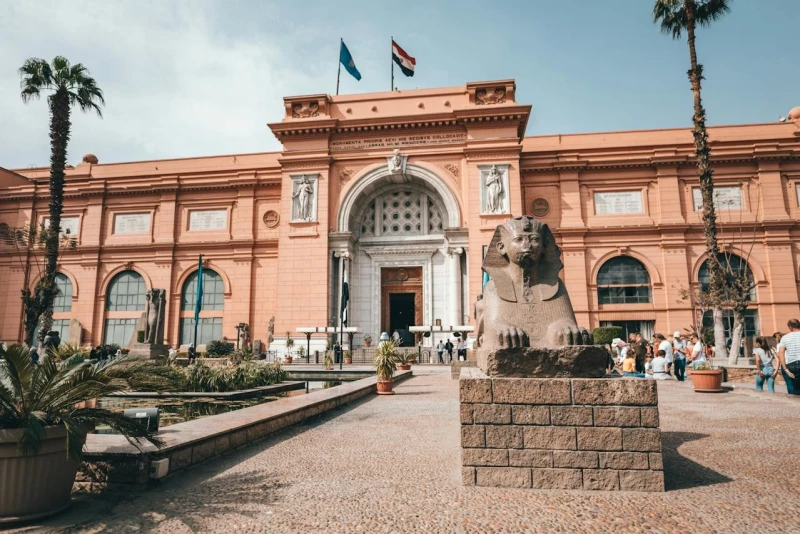
The Egyptian Museum in Cairo, also known as the Museum of Egyptian Antiquities, is one of the largest and most significant museums in the world dedicated to the history of ancient Egypt. Here is some information about this iconic museum:
-
Location: The museum is situated in the heart of Cairo, on Tahrir Square. It is easily accessible from various points in the city.
-
History: The Egyptian Museum was founded in 1858 by the French Egyptologist Auguste Mariette and opened to the public in 1902. Over the years, the museum underwent renovations and extensions to accommodate its vast collection.
-
Collection: The museum houses an immense collection of Egyptian antiquities, spanning from prehistoric times to the Roman era. The centerpiece is often considered to be the treasures from the tomb of Tutankhamun, including the famous gold funerary mask.
-
Tutankhamun's Treasures: The Tutankhamun exhibit showcases thousands of items found in the tomb of the young pharaoh, including his funerary mask, jewelry, furniture, and ritual objects.
-
Royal Mummies: The museum also boasts an impressive collection of royal mummies, including those of pharaohs such as Ramses II.
-
Animal Room: A section of the museum is dedicated to mummified animals, shedding light on the ancient practice of mummifying not only humans but also animals.
-
Papyrus Department: The museum has a department dedicated to papyrology, showcasing written documents such as medical, legal, and religious texts on papyrus.
-
Reopening and the New Grand Egyptian Museum: In 2021, the Egyptian Museum in Cairo partially reopened after a major renovation. It's important to note that the Tutankhamun collection will be relocated to the new Grand Egyptian Museum, located near the Giza Pyramids, which is expected to become one of the world's premier cultural attractions.
The Egyptian Museum in Cairo remains a must-visit for history and archaeology enthusiasts, providing a fascinating glimpse into the rich history of ancient Egypt.
 Our tips for getting the most out of your experience.
Our tips for getting the most out of your experience.
Visiting the Egyptian Museum in Cairo can be a rewarding experience. Here are some tips to make the most of your visit:
-
Plan Ahead: The museum is vast, with a multitude of artifacts. Plan your visit in advance by deciding which sections you want to prioritize exploring.
-
Hire a Guide: A local guide can provide in-depth information about the artifacts and Egyptian history. You'll learn more about the historical and cultural contexts.
-
Focus on Highlights: Ensure you see the museum's highlights, such as the Tutankhamun collection, royal mummies, and artifacts from the Pharaonic era.
-
Visit Tutankhamun's Room First: This room can get crowded. Visit it early in the morning or at opening time to avoid crowds.
-
Use an Audio Guide: If a guide isn't available, consider using an audio guide for detailed information about the displayed objects.
-
Check Opening Hours: Make sure you know the museum's opening hours and plan your visit accordingly. Avoid holidays or peak hours for a more peaceful experience.
-
Learn Some Egyptian History in Advance: Having a basic understanding of Egyptian history will enhance your appreciation of the displayed objects.
-
Be Aware of Photography Rules: Some areas of the museum may have restrictions on photography. Make sure to respect these rules for the preservation of the artifacts.
-
Take Your Time: The museum is extensive and filled with treasures. Take your time to admire each object and absorb the history surrounding them.
-
Bring Water and Snacks: A museum visit can be lengthy. Make sure to have water and possibly snacks to stay energized throughout your exploration.
-
Mind the Safety of Your Belongings: Like any tourist location, be vigilant about your belongings to avoid any security issues.
By following these tips, you'll be better prepared for a memorable experience at the Egyptian Museum in Cairo. Enjoy this fascinating dive into Egyptian history.
3 - City of the Dead
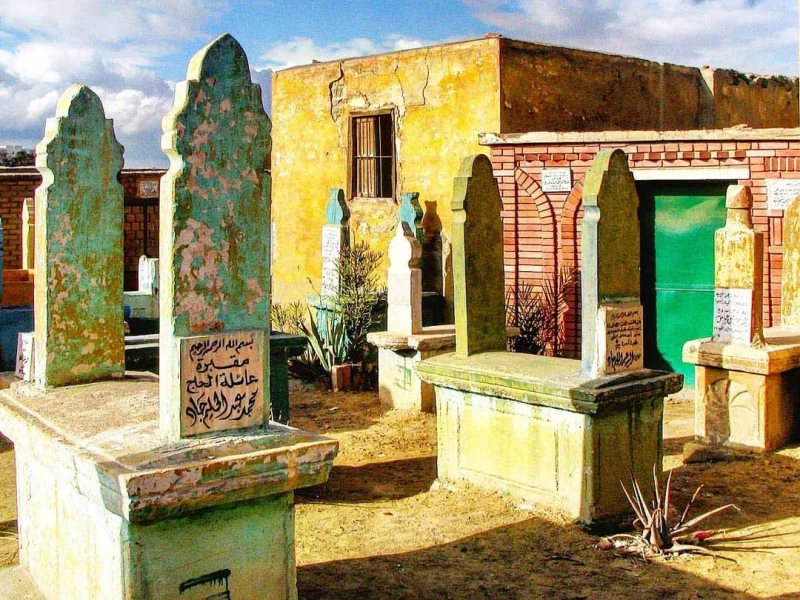
The City of the Dead, or "Qarafa" in Arabic, is a vast cemetery located in Cairo, Egypt. Here is some information about this unique place:
-
Location: The City of the Dead is situated to the east of Cairo, beyond the historic city walls. It spans several square kilometers and is often considered one of the largest cemeteries in the world.
-
History: The City of the Dead has a history dating back centuries. It began to take shape in the Middle Ages, and over time, it has become the final resting place for many Egyptians. Some of the mausoleums and tombs date back to ancient periods, while others are more recent.
-
Population: What sets the City of the Dead apart from traditional cemeteries is that people also live within this burial complex. The population resides among the tombs in sometimes challenging conditions, creating a unique community within the cemetery.
-
Daily Activities: Despite its origin as a cemetery, the City of the Dead is also an active living area. Residents often work in industries related to funeral services, such as coffin manufacturing and tomb maintenance.
-
Famous Mausoleums and Tombs: Some mausoleums and tombs in the City of the Dead are famous for their architecture, history, or the personalities buried there. Some visitors go there to explore these specific sites.
-
Tourism: Although it may seem unusual, the City of the Dead is sometimes visited by tourists who want to learn more about the daily life of people in this unusual cemetery and discover its cultural heritage.
-
Famous Residents: Over the centuries, the City of the Dead has become the final resting place for various historical figures and notable individuals. Exploring the graves can reveal interesting stories about the people buried there.
-
Cultural Respect: It is important to note that the City of the Dead is a resting place for many individuals, and it is essential to respect the sacred nature of this place. Visitors should exercise sensitivity and respect towards the community living and working there.
The City of the Dead bears witness to the rich and complex history of Cairo, offering a unique insight into the coexistence of daily life and eternal rest in the same location.
 Our tips for getting the most out of your experience.
Our tips for getting the most out of your experience.
Visiting the City of the Dead in Cairo can be a culturally enriching experience. Here are some tips to make the most out of your visit:
-
Cultural Respect: The City of the Dead is a resting place for many individuals, and it's essential to respect the sacred nature of this place. Exercise sensitivity and respect towards the community living and working there.
-
Engage in a Guided Tour: To gain a better understanding of the history, culture, and daily life in the City of the Dead, consider taking a guided tour. Local guides can provide valuable insights and help navigate the complex.
-
Avoid Private Areas: Some parts of the City of the Dead are private and reserved for families. Avoid entering restricted areas without permission.
-
Be Discreet with Photography: Ask for permission before taking photos, especially if photographing people. Some residents may not be comfortable with photography.
-
Respect Local Customs: If you enter spaces where funeral rites or ceremonies are taking place, be respectful and discreet. Avoid disrupting local activities.
-
Appropriate Clothing: Dress modestly out of respect for the local culture. Avoid overly revealing or provocative attire.
-
Bring Water and Snacks: As with any visit, make sure to have water to stay hydrated. Light snacks can also be helpful, especially if you plan for an extended visit.
-
Engage with Residents (if possible): If opportunities arise and you establish respectful communication, engage in dialogue with residents to learn more about their daily lives and experiences.
-
Be Aware of Prayer Days: Respect prayer days when certain activities may be restricted. Inform yourself about local practices and plan your visit accordingly.
-
Avoid Disturbing Tranquility: The City of the Dead is a place where families mourn their loved ones. Avoid disturbing the peace and serenity by respecting the quietude of the place.
By following these tips, you can make your visit to the City of the Dead more respectful and educational while contributing to preserving the integrity of the site.
4 - Stroll through the old Islamic city
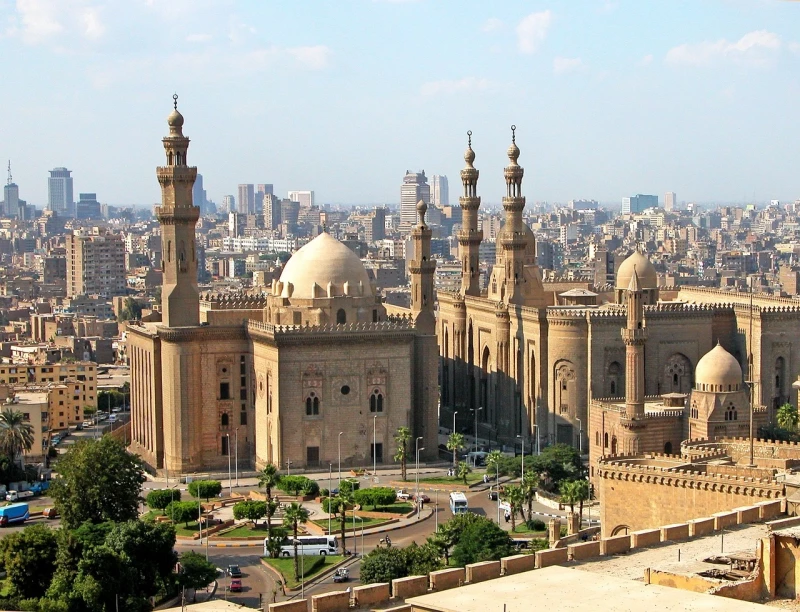
The Islamic Old City of Cairo, also known as Islamic Cairo, is a historic area filled with architectural and cultural sites dating back to the Islamic medieval era. Situated at the heart of Cairo, it is considered one of the oldest preserved urban areas globally. With a rich history dating back to the medieval Islamic era, it was founded in 969 AD and has since served as a political, religious, and cultural center.
Islamic Old City of Cairo is renowned for its numerous historic mosques. The Ibn Tulun Mosque, constructed in the 9th century, stands as one of the city's oldest. The Al-Azhar Mosque, founded in 970 AD, is one of the world's oldest universities.
In addition to mosques, the area houses ancient Quranic schools known as madrasas. Khan El Khalili, a historic market, is a must-visit in the Old City, famous for its lively atmosphere and craft shops.
Wander through the winding alleys and narrow passages of Islamic Old Cairo to discover ancient architecture and experience the authentic atmosphere of the region. Historic gates, like Bab Zuweila, provide panoramic views of the city from the ramparts.
Some historic palaces, such as the Palace of Emir Taz, are scattered throughout the Old City, bearing witness to the history of past leaders. The Old City is also a hub for cultural events, festivals, and celebrations, showcasing the richness of Islamic and Egyptian culture. It offers an immersive experience in history, architecture, and Islamic culture, making it a must-visit for history and heritage enthusiasts.
 Our tips for getting the most out of your experience.
Our tips for getting the most out of your experience.
Visiting the Islamic Old City of Cairo can be a captivating and immersive experience. Here are some tips to make the most of your visit:
-
Visiting Hours: Many historical sites open early in the morning. To avoid crowds and enjoy a more peaceful atmosphere, consider starting your visit early.
-
Guided Tour: Hire a local guide for in-depth information on the history, architecture, and Islamic culture of the Old City. Guides can help you navigate the winding streets and discover hidden gems.
-
Appropriate Attire: Respect local dress standards by wearing modest clothing, especially if you plan to visit religious sites. Shoulders, arms, and legs may need to be covered.
-
Explore Markets: Khan El Khalili is an iconic market in the Islamic Old City. Explore craft shops, taste local specialties, and practice the art of bargaining.
-
Discover Madrasas: Visit the ancient Quranic schools, known as madrasas, to understand the importance of education in Islamic culture.
-
Iconic Mosques: Don't miss iconic mosques such as the Ibn Tulun Mosque and Al-Azhar Mosque. Respect etiquette and prayer times.
-
Stroll Through Alleys: Deliberately get lost in narrow streets to discover ancient architecture, local markets, and the daily life of the residents.
-
Photograph Respectfully: Always ask for permission before taking photos, especially in sensitive areas like prayer spaces or local residences.
-
Avoid Peak Hours: Plan your visit to avoid peak hours, especially if you want to visit popular sites. This will allow for a more peaceful experience.
-
Sample Local Cuisine: Take the opportunity to taste traditional Egyptian dishes in local cafes and restaurants. Try regional culinary specialties.
By following these tips, you'll be better prepared for an enriching experience in the Islamic Old City of Cairo, delving into the history and culture of this fascinating area.
5 - Visit the Coptic Quarter
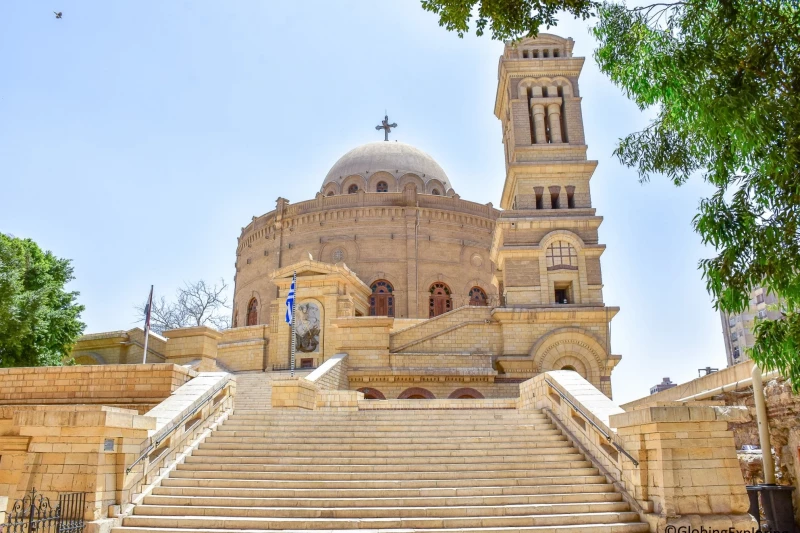
Cairo's Coptic Quarter, also known as Old Cairo, is an ancient and historic part of the city that houses a significant Christian community. Located to the south of Cairo, it is one of the oldest parts of the city, often referred to as Old Cairo due to its rich historical heritage.
The Coptic Quarter has an ancient history dating back to the early centuries of Christianity. It is home to some of Egypt's oldest churches, along with sites associated with the lives of early Christians. The Coptic Quarter is renowned for its iconic churches, with the Hanging Church (Saint Virgin Mary) being one of the most well-known. Other notable churches include the Church of St. Sergius and Bacchus and the Church of St. George.
In addition to churches, the Coptic Quarter is home to the Ben Ezra Synagogue, dating back to the 9th century and one of Cairo's oldest synagogues. The walls of Old Cairo and its gates, notably the Gate of Babylon, add a medieval atmosphere to the area.
The Coptic Quarter also features several interesting museums, including the Coptic Museum showcasing a collection of art and religious artifacts related to Coptic history. Explore the picturesque alleys to discover craft shops, traditional cafes, and an authentic atmosphere.
Situated along the Nile, the Coptic Quarter offers picturesque views and pleasant walks along the river. It hosts numerous religious events and festivities, particularly during Christian celebrations. When visiting churches and holy sites, ensure to respect local customs and specific conduct rules for each site.
Cairo's Coptic Quarter is a historical treasure that provides a fascinating insight into Egypt's Christian history, featuring ancient churches, charming alleys, and an atmosphere steeped in history.
 Our tips for getting the most out of your experience.
Our tips for getting the most out of your experience.
Visiting Cairo's Coptic Quarter can be a culturally rich experience. Here are some tips to make the most of your visit:
-
Iconic Churches: Explore the iconic churches of the Coptic Quarter, such as the renowned Hanging Church (Saint Virgin Mary), the Church of St. Sergius and Bacchus, and the Church of St. George. Respect conduct rules and prayer hours.
-
Ben Ezra Synagogue: Don't miss the Ben Ezra Synagogue, one of the oldest synagogues in Cairo. Explore its unique history and architecture.
-
Coptic Museums: Visit the Coptic Museum to discover a collection of art and religious artifacts related to Coptic history. It's an excellent opportunity to delve into the rich Christian history of Egypt.
-
Stroll Through Alleys: Deliberately get lost in the picturesque alleys of the Coptic Quarter. You'll discover craft shops, traditional cafes, and an authentic atmosphere.
-
Walls and Gates: Admire the ancient walls of Old Cairo and its gates, especially the Gate of Babylon. This adds a medieval dimension to your experience.
-
Khan El Khalili: If time allows, explore the nearby Khan El Khalili market for local crafts, souvenirs, and an immersion in the lively market atmosphere.
-
Visiting Hours: Plan your visit early in the morning or late in the afternoon to avoid crowds and enjoy a more peaceful atmosphere.
-
Respect for Religious Sites: When visiting churches, synagogues, and holy sites, be sure to respect local customs. Ask for permission before taking photos, especially in prayer areas.
-
Engage with Locals: If possible, engage in conversations with locals. You may learn more about daily life and the history of the Coptic Quarter.
-
Appropriate Attire: Dress modestly, especially if you plan to visit places of worship. Shoulders, arms, and legs may need to be covered as a sign of respect.
By following these tips, your visit to the Coptic Quarter will be more rewarding and respectful of the local culture. Take this opportunity to explore the Christian history and unique atmosphere of this ancient part of Cairo.
6 - Khan El Khalili market
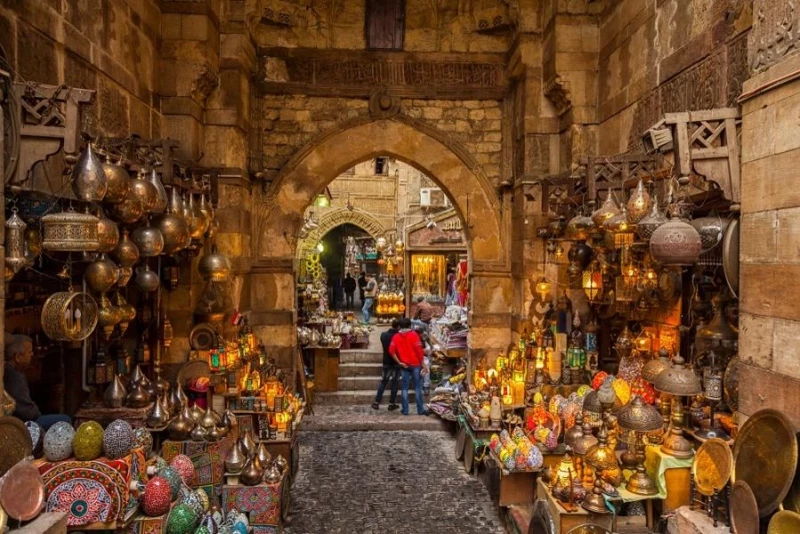
Khan El Khalili Market is one of Cairo's most iconic and bustling markets, offering a unique shopping experience and immersion in the vibrant atmosphere of the city. Here are some key points and tips to fully enjoy your visit to Khan El Khalili:
-
Colorful Atmosphere: Immerse yourself in the lively atmosphere of the market, with its narrow alleys filled with shops, stalls, and colorful stands.
-
Artisanal Shopping: Khan El Khalili is renowned for its handmade products. Explore the shops for items such as copperware, carpets, jewelry, scarves, and other local souvenirs.
-
Haggling: Haggling is an integral part of the experience at Khan El Khalili. Feel free to negotiate prices, but do so in a friendly and respectful manner.
-
Traditional Cafés: Take a break at one of the traditional cafes scattered throughout the market. It's an excellent way to soak up the local atmosphere while enjoying tea or coffee.
-
Visiting Hours: Khan El Khalili is particularly lively in the evening. To avoid crowds, consider visiting early in the morning or in the early afternoon.
-
Explore Side Alleys: Don't limit yourself to the main alleys. Explore side alleys to discover hidden treasures and less crowded shops.
-
Respect Cultures: Respect local customs and the cultural diversity of the market. Be mindful of prayer times and avoid photographing people without their permission.
-
Be Ready to Bargain: Traders can be persuasive; be prepared to decline politely if you don't wish to make a purchase.
-
Points of Interest: Don't miss iconic sites like the Al-Hussein Mosque and El Fishawy Café, one of the oldest cafes in Cairo located nearby.
-
Transport: Ensure you plan your transportation to and from the market. Taxis and public transportation are generally available in the area.
By following these tips, you can fully enjoy the unique experience that Khan El Khalili offers, with its artisanal treasures, lively atmosphere, and rich cultural heritage.
 Our tips for getting the most out of your experience.
Our tips for getting the most out of your experience.
Visiting Khan El Khalili Market can be an exciting and immersive experience. Here are some tips to make the most of your visit:
-
Immerse in the Atmosphere: Take the time to soak in the lively atmosphere of the market. Stroll through the alleys, observe the vendors, and enjoy the cultural diversity.
-
Explore Shops: Wander through shops and stalls to discover local crafts, jewelry, carpets, spices, clothing, and other unique souvenirs. Feel free to ask questions about the products.
-
Haggling: Haggling is common at Khan El Khalili. Feel free to negotiate prices, but do so in a respectful and friendly manner. It's part of the experience.
-
Discover Side Alleys: Don't limit yourself to the main alleys. Side alleys can hold interesting discoveries and offer a quieter atmosphere.
-
Traditional Cafés: Take a break in one of the traditional cafes. It's the perfect opportunity to enjoy a coffee or tea while observing the hustle and bustle of the market.
-
Visit Timing: Khan El Khalili is usually quieter in the early morning. If you prefer to avoid crowds, consider visiting the market early in the day.
-
Respect Local Customs: Be respectful of local customs and ask for permission before taking photos, especially of people.
-
Be Mindful of Personal Belongings: Like in any bustling market, be mindful of your personal belongings to avoid the risk of pickpocketing.
-
Try Local Cuisine: Take the opportunity to taste local snacks and traditional drinks offered by street vendors.
-
Explore Nearby Sites: Use your visit to explore nearby sites such as the Al-Azhar Mosque and the Coptic Quarter.
By following these tips, your visit to Khan El Khalili will be more rewarding, allowing you to fully experience the unique atmosphere of this vibrant market in the heart of Cairo.
7 - Manial Palace
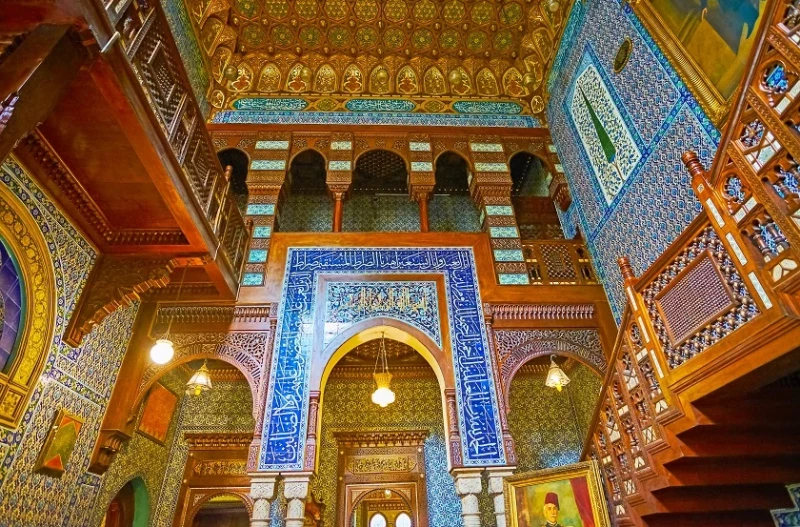
The Manial Palace, also known as the Prince Mohamed Ali Tawfik Palace, is a historic site located on the island of Manial in Cairo, Egypt. Here is some information about this remarkable palace:
-
History: The Manial Palace was built in the early 20th century by Prince Mohammed Ali Tawfik, a member of the Egyptian royal family. It was intended to be the prince's personal residence.
-
Architecture: The palace features a unique combination of architectural styles, blending Arab, Ottoman, and European elements. The palace gardens are also carefully landscaped, adding to the overall beauty of the site.
-
Art Collections: The palace houses a valuable art collection, including Islamic art, antique furniture, carpets, and other crafted items. Visitors can admire the elegance and cultural richness of these pieces.
-
Mosque: The Manial Palace also includes a beautifully designed mosque with exquisite architectural details. It is open to visitors and provides an immersive experience of Islamic architecture.
-
Gardens: The palace gardens are among the most impressive features. With shaded walkways, fountains, and a variety of plants, they offer a peaceful setting for a relaxing stroll.
-
Library: The palace houses a library that preserves a collection of rare Islamic manuscripts and ancient books.
-
Prince Mohamed Ali Tawfik Museum: Part of the palace has been converted into a museum showcasing personal items of Prince Mohamed Ali Tawfik, giving visitors insight into his life and era.
-
Cultural Events: The Manial Palace is sometimes used for cultural events, art exhibitions, and concerts, making it a dynamic venue beyond its museum status.
-
Accessibility: The palace is generally open to visitors, but it is recommended to check opening hours before planning your visit.
Visiting the Manial Palace not only provides a glimpse into Egyptian royal history but also offers an opportunity to appreciate art, architecture, and the beautiful gardens that make it a culturally rich destination worth exploring.
 Our tips for getting the most out of your experience.
Our tips for getting the most out of your experience.
Visiting the Manial Palace can be a culturally enriching experience. Here are some tips to make the most of your visit:
-
Pre-Visit Research: Before your visit, gather information about the history of the palace and the Egyptian royal family. This will enhance your experience and allow you to better appreciate the collections.
-
Opening Hours: Check the opening hours of the Manial Palace. Make sure to plan your visit considering the opening hours and any potential exceptional closures.
-
Guided Tour: If possible, opt for a guided tour. Guides can provide detailed information about the palace's history, architecture, and the displayed objects, making your visit more informative.
-
Respect Rules: Respect the rules and regulations of the palace. This includes behavior in exhibition areas, photography rules, and any other specific protocols.
-
Architectural Observation: Take the time to appreciate the unique architecture of the palace. Observe artistic details, design elements, and the combination of architectural styles.
-
Gardens: Explore the palace gardens. Well-maintained gardens offer a peaceful atmosphere, perfect for a relaxing stroll. Enjoy shaded pathways, fountains, and landscaping.
-
Museum: If the palace houses a museum, allocate time to explore the exhibits. Admire art collections, historical artifacts, and personal items of Prince Mohamed Ali Tawfik.
-
Mosque: If the palace includes a mosque, visit it. Appreciate the religious architecture and the spiritual atmosphere it may convey.
-
Cultural Events: Inquire about any cultural events or temporary exhibitions that may take place during your visit. This could add an additional dimension to your experience.
-
Interaction with Staff: If the opportunity arises, engage in conversation with palace staff. They may provide additional information and share interesting anecdotes about the location.
By following these tips, your visit to the Manial Palace will not only be informative but also filled with appreciation for Egyptian history, architecture, and culture.
8 - Al-Azhar Park
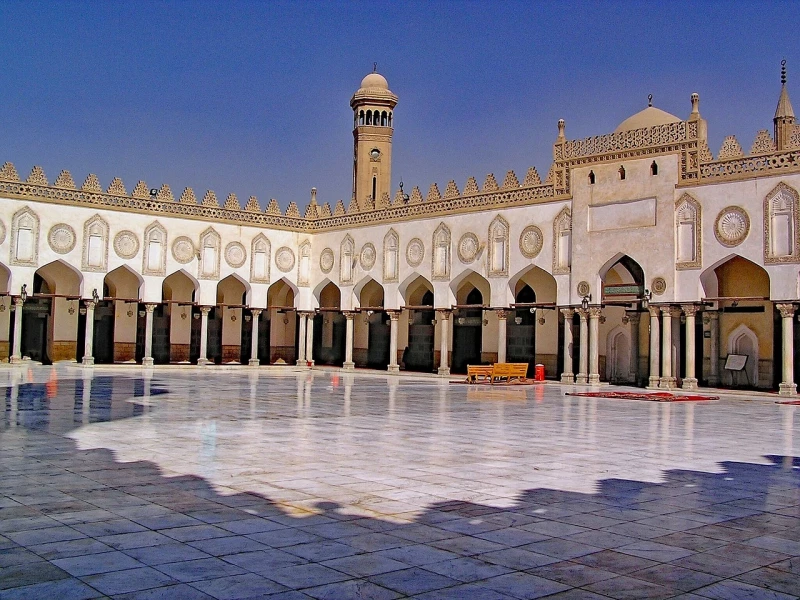
Al-Azhar Park, located in Cairo, is an iconic green space providing a peaceful oasis in the midst of urban hustle and bustle. Here is some additional information about this park:
-
Location: Al-Azhar Park is situated in the historic Islamic Cairo district, near the Al-Azhar Mosque, one of the oldest universities globally.
-
Creation: Inaugurated in 2005, the park is the result of an urban revitalization project initiated by the Aga Khan Trust for Culture. It transformed a dilapidated site into a beautiful landscaped park.
-
Landscape Design: The park was designed with carefully landscaped gardens, fountains, paved pathways, and resting areas, drawing inspiration from traditional Islamic aesthetics.
-
Panoramic View: A major attraction of Al-Azhar Park is the panoramic view it offers of the old city of Cairo. Visitors can admire minarets and historical landmarks while enjoying a tranquil setting.
-
Park Features: The park offers green spaces for picnics, playgrounds for children, cafes, and pleasant walks. Visitors can also explore the gardens and various zones within the park.
-
Cultural Activities: Al-Azhar Park occasionally hosts cultural events such as concerts, art exhibitions, and other activities that enhance the visitor experience.
-
Entrance: Access to the park may require an entrance fee, with varying rates based on nationality and age. Some days of the week may offer free entry.
-
Opening Hours: It is advisable to check the park's opening hours before your visit, as they may vary depending on the day of the week and seasons.
Al-Azhar Park is an ideal place to escape the city's hustle, unwind, and appreciate the natural and cultural beauty of its surroundings. Before visiting, make sure to check current information to plan your experience effectively.
 Our tips for getting the most out of your experience.
Our tips for getting the most out of your experience.
Visiting Al-Azhar Park can be a rewarding experience. Here are some tips to make the most of your visit:
-
Pre-Visit Information: Before you go, research the history of the park, its architectural features, and cultural significance. This background knowledge will enhance your appreciation during your visit.
-
Opening Hours: Check the park's opening hours before you head out. Make sure to plan your visit around the opening times and any potential exceptional closures.
-
Tour Guides: If available, consider hiring a tour guide to provide in-depth information about the park, its history, and unique features.
-
Explore the Gardens: Take the time to explore the park's gardens. Admire the landscape design, fountains, and relaxation areas. Gardens often provide quiet spots for rest.
-
Panoramic View: Don't miss the panoramic view from the park. Find strategic spots that offer a clear view of the old city of Cairo.
-
Photography: Capture memorable moments with your camera, but be mindful of the park's photography rules, especially in specific restricted areas.
-
Cafes and Relaxation: Enjoy the park's cafes for relaxation. Some parks offer shaded resting areas where you can sit and soak in the peaceful atmosphere.
-
Cultural Activities: Check the schedule of cultural activities. Some parks host special events, concerts, or exhibitions that can enrich your experience.
-
Respect Rules: Respect the park's rules and regulations. This includes environmental preservation, consideration for other visitors, and following staff instructions.
-
Tickets and Rates: Ensure you have the necessary tickets and check entrance fees, taking into account any discounts for students or groups.
By following these tips, your visit to Al-Azhar Park will be more enjoyable and memorable, allowing you to fully appreciate the beauty of the park and its unique ambiance.
9 - Take a Nile Cruise
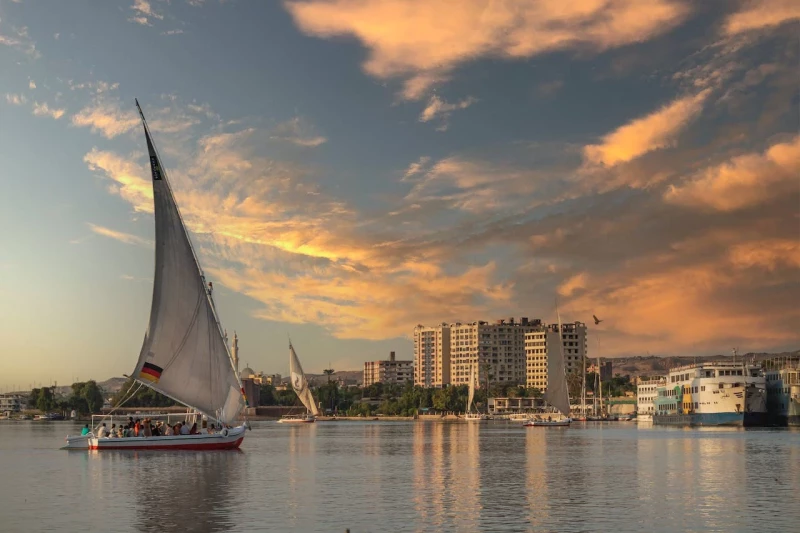
A Nile cruise is an unforgettable experience that allows you to explore some of Egypt's most iconic historical sites while sailing along the legendary river. Here are some considerations to make the most of your Nile cruise:
-
Itinerary: Choose an itinerary that aligns with your interests. Cruises may vary in terms of duration, stops, and offered activities.
-
Visited Sites: Ensure the itinerary includes stops at key historical sites such as the temples of Karnak, Luxor, Edfu, Kom Ombo, and the famous temples of Abu Simbel.
-
Cruise Ship: Select a cruise ship that fits your preferences in terms of comfort, services, and style. Some ships offer luxury amenities, while others prioritize a more authentic experience.
-
Travel Season: Consider the season of your travel. Temperatures in Egypt can vary significantly, so choose a time of the year when you feel comfortable.
-
Guides and Excursions: Inquire about the availability of qualified guides for onshore excursions. Experienced guides can provide rich insights into Egyptian history and culture.
-
Onboard Activities: Some boats offer onboard activities such as lectures on Egyptian history, cultural performances, and cooking classes. Check for available options.
-
Sunset on the Nile: Enjoy the breathtaking sunset over the Nile from the deck of the boat. It's often a magical moment during the cruise.
-
Free Time Onboard: Use free time onboard to relax, take advantage of the boat's facilities, and socialize with fellow travelers.
-
Photography: Bring a camera to capture the spectacular views along the Nile. The riverbanks offer unique landscapes.
-
Crew Tips: Don't forget to show your appreciation to the boat's staff, including guides, crew members, and service personnel.
A Nile cruise combines cultural exploration with the comfort of a boat journey, providing a unique perspective on Egypt's ancient history.
10 - Visit the Citadel of Saladin and the Mohammed Ali Mosque
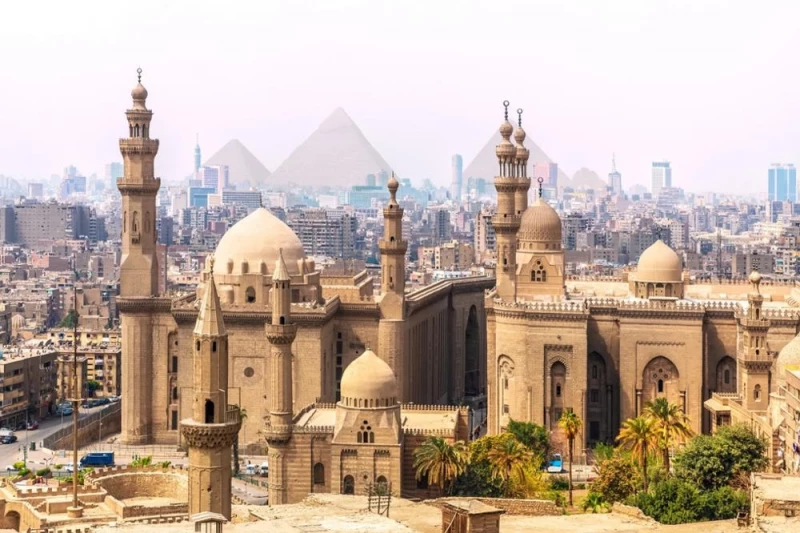
Visiting the Saladin Citadel and the Mohammed Ali Mosque in Cairo promises a captivating dive into Egyptian Islamic history and architecture. Perched on a hill, the Citadel offers breathtaking panoramic views of Cairo, revealing its bustling streets and iconic minarets. Before delving into exploration, acquainting oneself with the rich history of these sites enhances the overall appreciation.
The Mohammed Ali Mosque, nestled within the Citadel, stands as an architectural masterpiece. Its majestic domes and minarets crafted from alabaster command attention, while the interior unveils a splendid central dome and intricate artistic details. Strolling through the courtyard, one can admire the fountain and soak in the serenity of this religious space.
The Citadel's gardens provide a tranquil escape, inviting relaxation amid the city's hustle. It's advisable to dress modestly, covering shoulders and knees, respecting the sanctity of the religious sites. For a more enriching experience, hiring a guide can provide valuable insights into the history, art, and spirituality of these iconic locations. Capture these memorable moments with your camera, but be mindful of photography rules within religious sites. Don't forget to purchase the necessary tickets to fully enjoy this cultural immersion.
 Our tips for getting the most out of your experience.
Our tips for getting the most out of your experience.
Visiting the Saladin Citadel and the Mohammed Ali Mosque in Cairo is a culturally enriching experience. Here are some tips to enhance your visit:
-
Prior Historical Knowledge: Before you visit, familiarize yourself with the history of the Saladin Citadel and the Mohammed Ali Mosque. This will deepen your understanding and appreciation of the sites.
-
Appropriate Dress Code: Respect local customs and dress modestly, covering shoulders and knees, especially if you plan to enter the mosque.
-
Tour Guide: Hiring a tour guide can be beneficial. Guides can provide detailed historical and cultural information, making the visit more immersive.
-
Opening Hours: Check the opening hours of the Citadel and the Mohammed Ali Mosque. Plan your visit to avoid peak times and enjoy a more serene experience.
-
Panoramic View: Take advantage of the panoramic view from the Citadel. Choose a suitable time, such as sunset, for an even more spectacular experience.
-
Architectural Details: Take the time to admire the architectural details of the Mohammed Ali Mosque, including its alabaster domes and minarets.
-
Mosque Courtyard: Explore the courtyard of the mosque. The fountain and the surrounding architecture create a serene atmosphere.
-
Citadel Gardens: Stroll through the gardens of the Citadel. It's a peaceful place to relax and appreciate the surroundings.
-
Photography: Respect photography rules, especially inside the mosque. Capture moments but be mindful of the sacred atmosphere.
-
Tickets: Ensure you have the necessary tickets for the Citadel and the Mohammed Ali Mosque. Some fees may vary depending on your nationality.
By following these tips, you'll maximize your experience when visiting the Saladin Citadel and the Mohammed Ali Mosque, uncovering the history and architectural splendor of these iconic sites.
11 - Cairo Tower
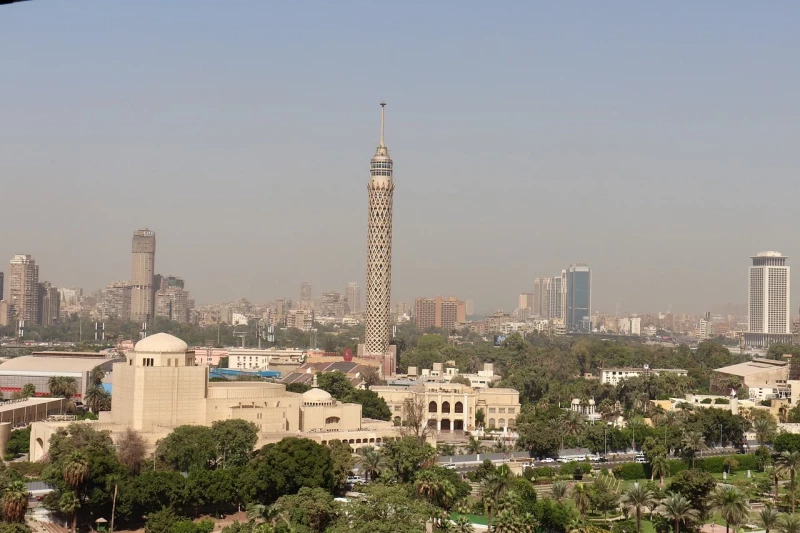
The Cairo Tower, a landmark in the heart of Cairo, is situated on Gezira Island in the Zamalek district, amidst the Nile River. Designed by Egyptian architect Naoum Chebib, it was completed in 1961. With a height of approximately 187 meters, the tower boasts a distinctive architecture inspired by the Pharaonic era, characterized by its slender form and wrought iron structure.
At the tower's summit, an observatory provides a breathtaking 360-degree panoramic view of Cairo. A revolving restaurant and café offer visitors the opportunity to savor dishes while enjoying the ever-changing landscape. Illuminated at night, the Cairo Tower creates a spectacular image visible from various points across the city.
Beyond its role as an observatory, the Cairo Tower has become a popular tourist attraction, drawing those seeking a memorable view of the Egyptian capital. Before visiting, be sure to check the opening hours to fully appreciate this unique experience.
 Our tips for getting the most out of your experience.
Our tips for getting the most out of your experience.
Visiting the Cairo Tower can be a memorable experience, offering a spectacular panoramic view of the city. Here are some tips to enhance your visit:
-
Off-Peak Hours: Try to visit the tower during off-peak hours to avoid crowds. This can make the experience more enjoyable and allow for unobstructed photo opportunities.
-
Sunset: Plan your visit to include sunset from the tower. The view of the illuminated city at dusk is often spectacular.
-
Tickets: Make sure to purchase your tickets in advance, if possible, to avoid lines at the entrance.
-
Camera: Bring a high-quality camera to capture the panoramic view from the observatory. The sprawling city below offers excellent photography opportunities.
-
Revolving Observatory: If the restaurant and observatory are revolving, consider booking a table for a unique dining experience while enjoying the changing cityscape.
-
Night Lighting: If possible, visit the tower both during the day and at night to appreciate the nighttime lighting of the city from the observatory.
-
History: Familiarize yourself with the history of the Cairo Tower before your visit. Understanding its architectural and cultural significance will add an extra dimension to your experience.
-
Dress Comfortably: Dress comfortably, taking into account the local climate. If you plan to dine at the restaurant, check if there is a specific dress code.
-
City Information: Use the informational panels or tourist guides available at the observatory to learn more about the different neighborhoods of the city you can see.
-
Respect Rules: Respect the rules and guidelines provided by the tower staff. This will ensure an enjoyable visit for all visitors.
By following these tips, you'll fully enjoy your visit to the Cairo Tower, providing an unforgettable experience of the Egyptian capital from above.
Cairo - Where to Stay?
Cairo offers a variety of accommodation options to cater to the needs and preferences of visitors. Here are some popular neighborhoods where you might consider staying in Cairo:
-
Downtown Cairo: This area is the commercial heart of the city, housing luxury hotels, businesses, and shopping malls. It's an excellent choice for those who want to be in the center of the action.
-
Zamalek: Located on a Nile island, Zamalek is an upscale neighborhood with many quality hotels, trendy restaurants, and a more relaxed ambiance than downtown.
-
Garden City: An elegant residential neighborhood with embassies and tranquil surroundings. It also offers quality accommodation options.
-
Maadi: Located south of downtown, Maadi is a popular residential area among expatriates. It provides a calm atmosphere with parks, restaurants, and shops.
-
Heliopolis: A residential and commercial neighborhood situated east of downtown. Heliopolis offers a variety of hotels and is known for its friendly atmosphere.
-
Giza: If you want to be close to the pyramids, Giza is an option. You'll find hotels with pyramid views, providing a unique experience.
-
Nasr City: A residential neighborhood with shopping malls, restaurants, and a variety of accommodation options.
-
Dokki: Located on the west bank of the Nile, Dokki is a popular residential area with accommodation choices and relatively easy access to major attractions.
Before choosing your place of stay, consider your preferences in terms of location, budget, and planned activities. Also, be sure to check online reviews to get an idea of other travelers' experiences in different areas of the city.
Cairo - How to get around?
Cairo is a bustling city with a diverse transportation network to facilitate movement within the urban landscape. Here are several modes of transportation you can use in Cairo:
-
Taxis: Taxis are widely available throughout the city. Make sure the driver uses the meter or negotiate the fare before getting into the taxi.
-
Car Rentals: You can rent a car, but traffic in Cairo can be dense, and driving may be chaotic. Ensure you are comfortable with the local driving style if you choose this option.
-
Uber/Careem: Ride-hailing services like Uber and Careem are popular in Cairo. They provide a comfortable and often more predictable alternative to traditional taxis.
-
Metro: Cairo has a metro system that serves various parts of the city. It is an efficient and cost-effective way to travel, especially during peak hours.
-
Microbuses: Microbuses are minibusses that follow specific routes in the city. They serve as a form of public transportation, but quality and safety can vary.
-
Buses: Cairo has a public bus network. Buses are affordable, but the network may be challenging to navigate if you do not speak Arabic.
-
Walking: In certain parts of the city, walking can be a viable option, especially around tourist areas like downtown.
-
Cycling: While Cairo may not be the most bicycle-friendly city due to heavy traffic, there are initiatives to develop cycling routes.
It's essential to plan your transportation based on your destination, budget, and comfort. Keep in mind that traffic in Cairo can be intense, especially during peak hours, and the choice of transportation will often depend on your specific route and personal preferences.
Cairo - Best period
The best time to visit Cairo depends on individual preferences regarding climate and activities. However, here are some general recommendations:
-
Spring (March to May): Spring is often considered the best time to visit Cairo. The temperatures are generally pleasant, ranging between 20°C and 30°C. It's an ideal period to explore the city and its tourist sites without the extreme summer heat.
-
Autumn (September to November): Like spring, autumn offers moderate temperatures. It's a good time to visit Cairo before cooler winter temperatures set in.
-
Winter (December to February): Winter months in Cairo are mild but can sometimes be cool, with daytime temperatures around 15°C to 20°C. It's a pleasant time to visit if you prefer cooler temperatures.
-
Summer (June to August): Summer in Cairo can be very hot, with temperatures often exceeding 35°C or more. If you choose to visit during this period, be prepared for hot and sunny days. It's recommended to stay hydrated and plan indoor activities during the hottest hours.
It's important to note that the high tourist season in Cairo typically coincides with spring and autumn when the weather is more agreeable. However, these periods can also be busier. Depending on your preferences for climate and crowds, you can choose the time that best suits your travel plans.
